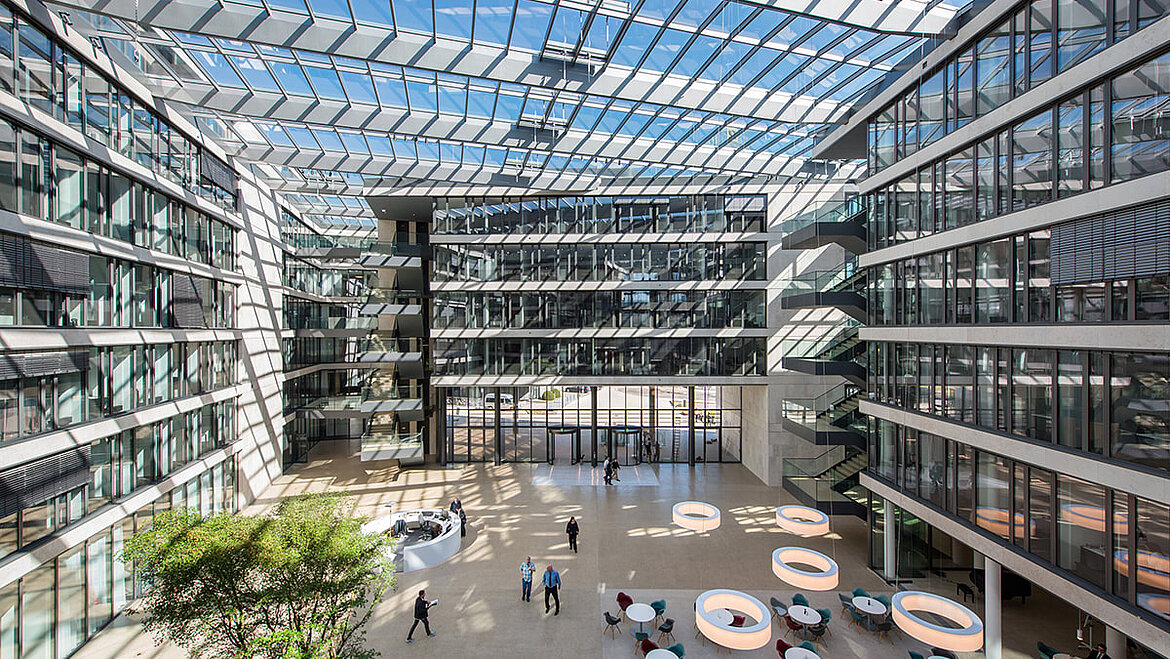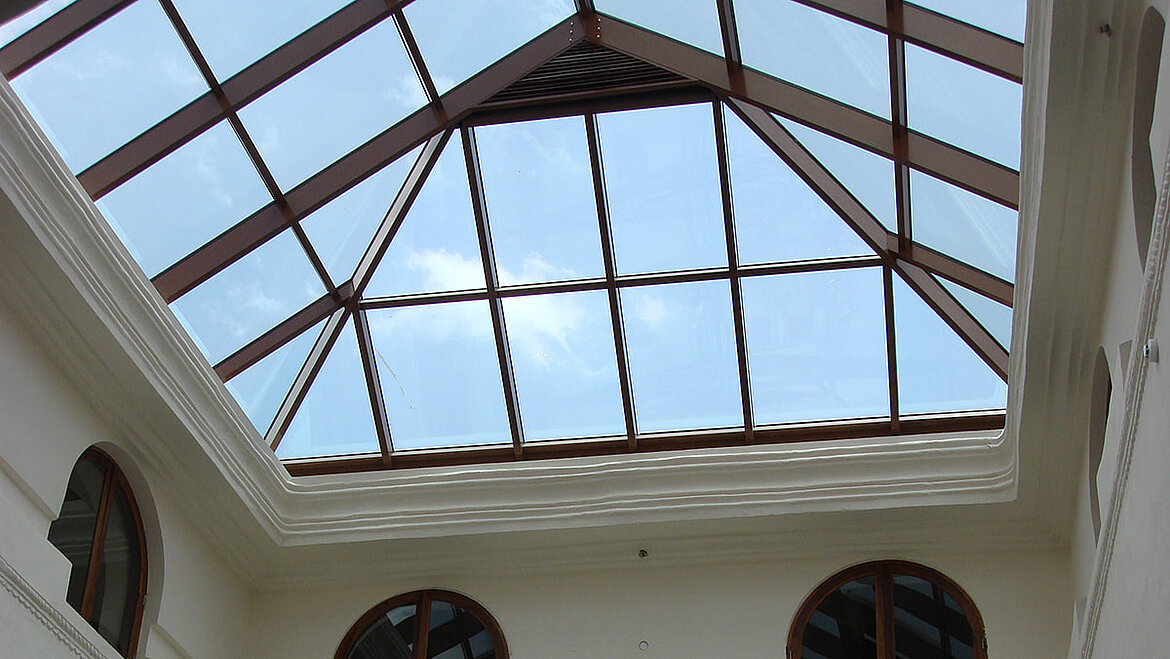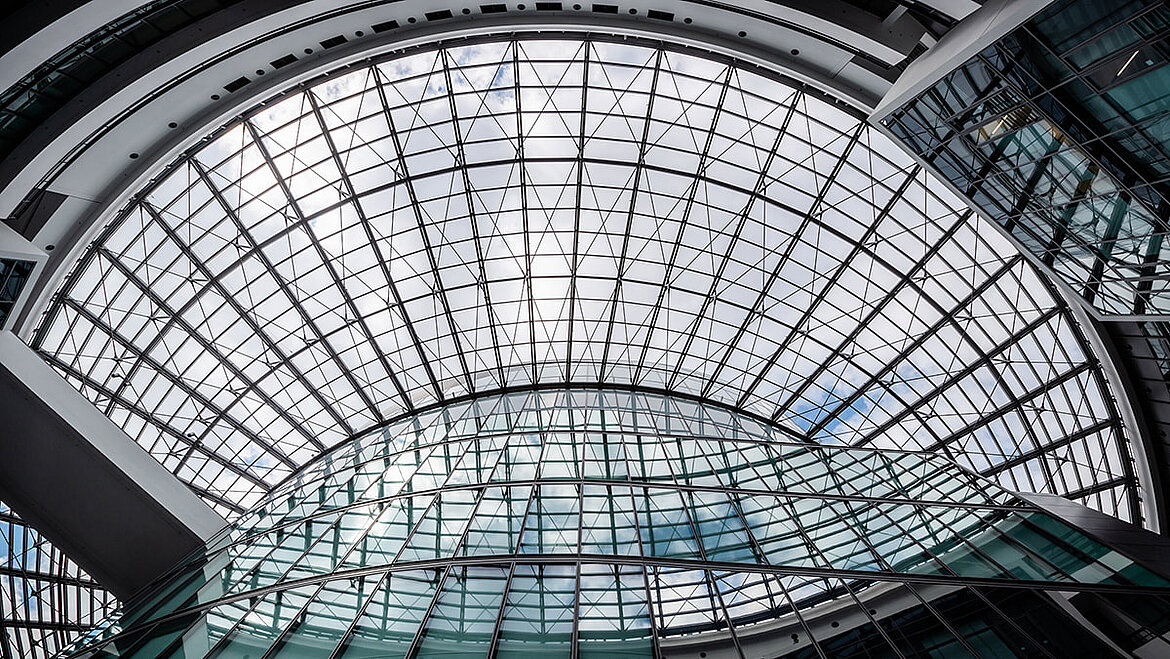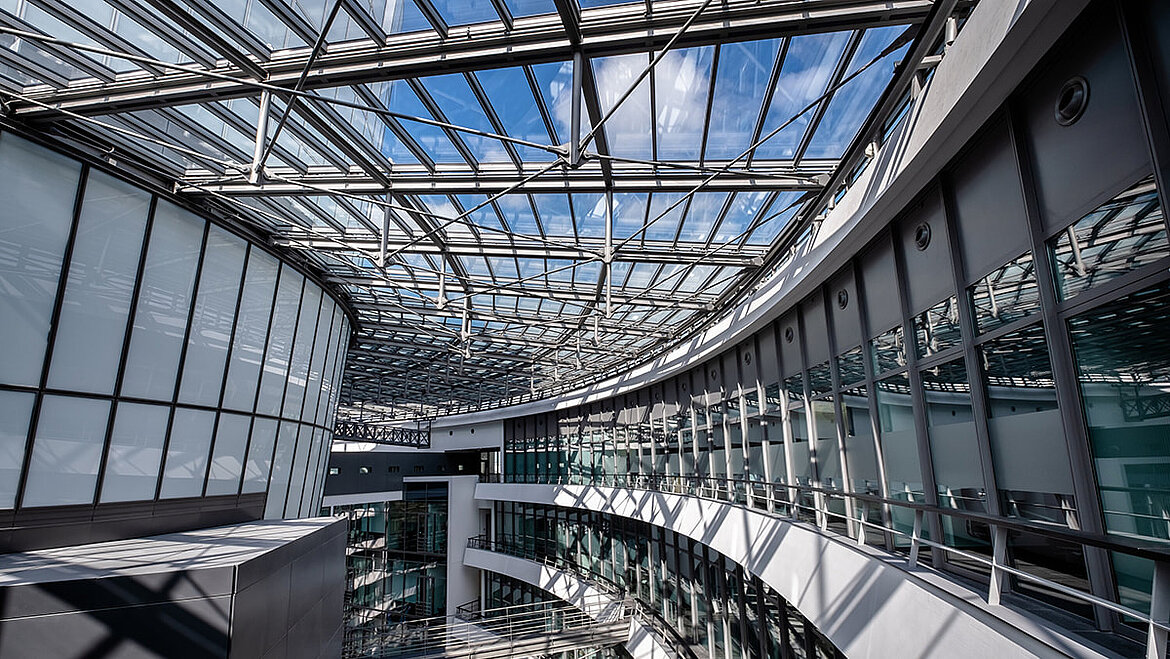Design of modern glass roof architecture
Glass roof constructions consist of two important main components: Glass and metal supports - aluminium for smaller spans and steel for larger spans. From the 19th century onwards, glass architecture made great strides and developed into a characteristic feature of modern building: unique glass architecture as a building roof. This is mainly because glass and steel became more quickly producible and more easily available. Since then, more and more possibilities have opened up for building special and unique elements with the appropriate know-how.
But what are the advantages and how is modern glass roof architecture designed? Particularly in department stores, hotels or exhibition halls in various conurbations, glass roof constructions allow a great deal of daylight into the building, which has been proven to benefit visitors: Daylight creates a pleasant room atmosphere, gives brightness and creates a feeling of space and freedom even in urban environments. The following projects show you what we are talking about.
Relaxation with daylight

The Siebenquell GesundZeitResort in Weißenstadt is a retreat for wellness lovers and spa guests. Visitors can relax and recuperate on almost 100,000 square meters of thermal spring, beauty area and spa. The decisive factor for the feel-good factor there: the room atmosphere created by daylight.
"In a health resort, the incidence of daylight plays a special role", explains planner Johannes Fischer. Artificial light is strenuous and tiring for our eyes. So, particularly in large buildings, skylights are important for flooding interior rooms with daylight. In Weißenstadt, the planners opted for different types of glass roof.
The highlight: the approximately 8.5 tonnes LAMILUX PR60 glass pyramid above the entrance to the Healthy Time Travel thermal spa area, which was placed on the roof in elaborate millimetre work. And it was not only the thermal baths area that was upgraded by the ingenious post and beam system. In the chapel, too, a cross-shaped LAMILUX PR60 glass roof underlines the devotional atmosphere.
Detailed planning for glass architecture in large dimensions
The LAMILUX PR60 glass roof on the FGS Campus in Bonn measures 1700 square metres. The impressive glass surface spans the entire inner courtyard of the building and creates a pleasant atmosphere. On their way to the office, the library or the cafés, guests fill up on daylight, feel like they are outside and can adjust their internal clock to the time of day. After all, this is something we often lose in closed rooms.


However, to build this unique glass architecture 22 metres above the ground, a great deal of know-how and well-thought-out planning was required. Steel girders up to 40 metres long were lifted to the planned locations by a 500-tonne mobile crane. To ensure that the crane also stood on solid ground, a parking space was built for this project. The steel girders used are unique specimens which MIROTEC manufactured especially for this project. They form a stable basis for the aluminium construction of the PR60 glass roofs from LAMILUX and allow for individual design. The metal and glass construction company MIROTEC is a subsidiary of the daylight specialist LAMILUX. Together, the companies regularly carry out projects of this type, large or small, and deliver one thing above all: high-quality complete systems from a single source.
Seen from above, the windmill-shaped glass roof of the FGS Bonn connects the four parts of the building. But the glass architecture not only looks impressive, it also offers further technical refinements: LAMILUX integrated drainage channels in the steel girders, so that rain and condensation do not collect on the roof, but drain off to the side.
Glass roof in Africa between tradition and modernity
But not only new buildings can impress with unique glass roofs. In the Park HYATT Hotel in Zanzibar, true-to-original elements of the old building are combined with modern materials. As visitors get their first impression of the hotel directly in the lobby, it should be as representative of the building as possible. The skylights gave the lobby a bright and pleasant room atmosphere. The simple furnishings and the neutral design run through the entire five-star hotel and ensure relaxation and recreation.
But the refurbishment was demanding: As the ageing building is a listed building, the architects worked intensively on the choice of materials and planning. Architect Kerstin Uckrow opted for natural lighting of the rooms using the square LAMILUX glass roof PR60 pyramids. In order to convince the clients of this decision, the Rehau-based family company created a haptic model to illustrate the incidence of light and the effect. The 612 kilogram construction thus found its place on the hotel roof.


Before the restoration, the wooden construction that supports the roof of the building was covered with sheet metal, so no daylight entered the entrance area. The new glass roof structures set the wooden beams, which were restored in the original, in scene and allow daylight to flow through the room. Due to the individual colouring of the aluminium profiles, the glass roofs perfectly matches the wooden details in the hotel, creating a uniform design.
Large-scale glass architecture to amaze
The project house of BMW's Research and Innovation Center is also particularly impressive. A total of 900 panes of the atrium roof surround the studio workshop building and provide it with plenty of natural daylight. The numerous workplaces are shielded by additional glass fronts, so that the rooms are separated but always brightly lighted, creating a pleasant working atmosphere. In addition, the glass surfaces symbolize transparency, stimulate communication between employees and make working together easier. Toward work, employees feel as if they are out in the open and experience all weather changes in a protected place.


In order to realize this though, the glass and steel construction required detailed planning. Since the roof is only slightly inclined, the planners paid particular attention to good water drainage on the secondary drainage level.
The hundreds of panes of the LAMILUX Glass Roof PR60 are also the result of elaborate precision work. But the effort was worth it: The BMW FIZ impresses many visitors with its unique glass architecture.
Unique room atmosphere thanks to glass roof construction
Great personalities such as Queen Elizabeth II, Elton John or even Michael Jackson have already been guests at the Hotel Vier Jahreszeiten in Munich. And not without reason: the five-star hotel is one of the best and most profitable accommodations in Germany. Above all, the furnishings and design of the building underline the high-quality and exclusive character of the hotel.
The lobby is characterised by the dark wood panelling, which gives the room warmth. But to make the room atmosphere even more atmospheric, the glass mosaic above the reception area creates a unique play of light. To ensure that the many colours of the mosaic shine out, the glass pyramid above lets light into the interior of the building, thus illuminating the room in an indirect and cosy way. The octagonal LAMILUX PR60 glass roof is adapted to the size of the mosaic, so that each pane is illuminated more or less depending on the weather, creating a special effect in the lobby.


To ensure that the construction can also withstand the weather in winter, it resists a snow load of 0.75 kN/m^2. That means, even with a large amount of snow there is no risk of the glass roof breaking. In addition, a ventilation panel is built into the glass pyramid to prevent condensation formation in the space between the mosaic and the glass roof. As a result, the construction does not only look elegant but is also functional and safe.


